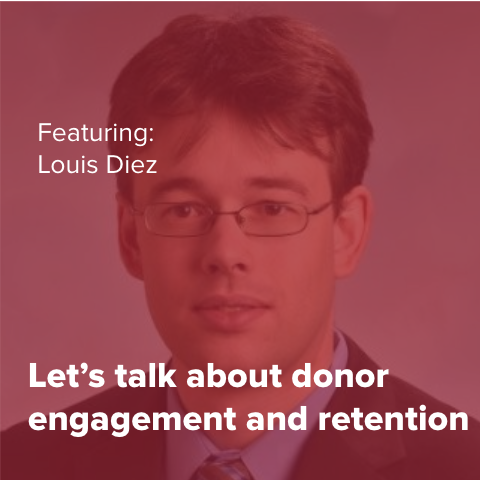Mike sat down with Louis Diez, Executive Director of Annual Giving at Muhlenberg College, for a chat about why donor retention matters. When national donor counts and alumni participation dropped after COVID hit, Louis wanted to bring advancement folks together to discuss the trend and share ideas about how to turn things around. So, he started the Donor Participation Project, and it grew into a space where hundreds of folks are batting around topics like recurring gifts, the subscription economy, the costs of acquisition versus retention, and donors as customers, partners, or even investors.
Louis is so well-read and researched on the topic of donor engagement and retention, and we’re all lucky to spend 35 minutes inside his brain. There’s a lot to learn from this conversation.
From Last-Stand-Violist to Executive Director of Annual Giving
Mike:
Louis, thank you so much for taking the time to sit down with me. Tell me about your role at Muhlenberg College and tell me about the Donor Participation Project.
Louis:
I thought I was going to be a symphony violist, but then I saw a Grey’s Anatomy episode where they said, “Nobody wants to be the last standing violist.” And that was actually me at the Knoxville Symphony. So, that caused me to take a big career change. I’m kind of joking, but I’ve always been a musician and I’ve also studied business. Back in Spain, I did an MBA and then I got to my PhD. Finally, I got into development at my alma mater, the University of Tennessee at Knoxville. Several steps later, I was at Hopkins. Now, I’m really enormously thrilled to be with Muhlenberg College in Allentown, Pennsylvania. It is a fantastic school. I am the Executive Director of Annual Giving.
Mike:
So, what does that mean you do on a daily basis? And then tell us about your “5 to 9,” The Donor Participation Project.
Louis:
The annual fund at Muhlenberg is a team of 7 professionals. We raise current use restricted and unrestricted dollars for Muhlenberg. So, it’s basically all those gifts that have an immediate impact on the students, on the research, on the opportunities and the great work that’s happening at Muhlenberg. We run a full annual fund in the higher-ed sense with a phone-a-thon, vigorous email, and direct mail schedule. We’re experimental with new things on the digital side, including monthly gifts and social media activity.
Why Does Donor Retention Matter?
Louis:
During the pandemic, I saw a need for people to get together and talk about donor participation issues. It’s a topic that none of the big consultants were talking about, except for maybe one or two. And it’s super important. I mean, we were seeing this huge decline [in donor counts]. It’s a landslide. People were becoming disengaged with our organizations, which eventually means they will stop giving. So, we just started talking about this issue. We got together. It was a group. We became very active on LinkedIn. One thing led one another. Just yesterday, we had a great session with Jim Langley and we had a hundred people chatting in and asking questions and learning.
Mike:
We’re right there with you. Participation and donor retention matter because they are the best way to gauge the health of a current organization. Are you keeping the people who are already close to you close to you, and are you setting yourself up for future success? The health of our organizations and our colleges, universities, or independent schools is directly correlated to the work we’re doing now. 25 years down the road, 50 years down the road, who’s going to be giving those major gifts that we’re so reliant on? The answer is: the folks that are making annual gifts today.
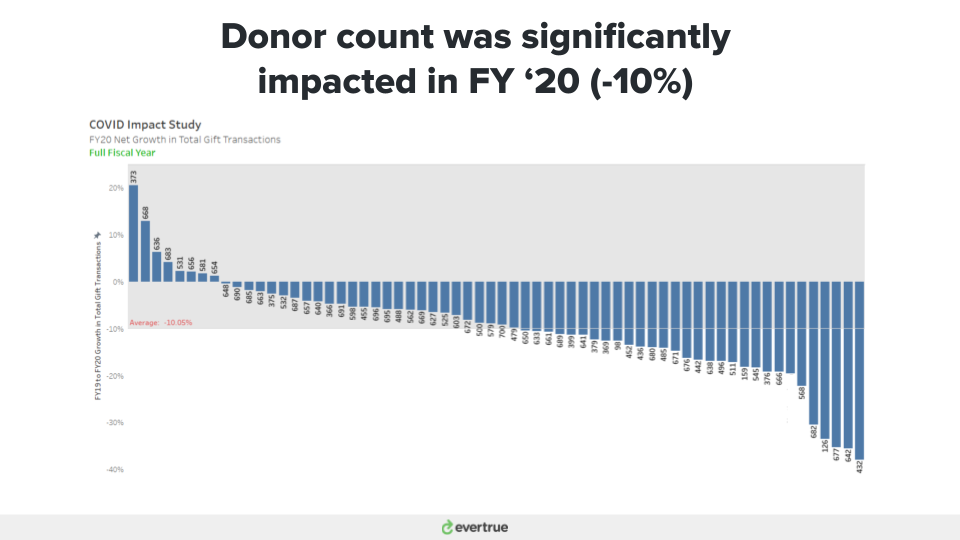
Louis:
And that’s one argument. You have to do it for strategic reasons because after we’re all gone, this is going to be the pipeline for the ones that come after us. But also there’s this trade-off between efficiency and risk. Obviously, the attraction of only focusing on major gifts and principal gifts is that it’s more efficient, right? I hope this simplification won’t insult people. But, you have dinner a couple of times [with a principal gift prospect]. You engage them. They’re on a board. And so, the level of time investment is less than with annual fund work where you’re sending letters and emails to a lot of constituents and then getting $10 gifts, all very valuable and appreciated as everybody here knows. But [in principal giving] you’re depending a lot more on fewer people.
And that puts you in a risky situation. So, when something like COVID hits, or when another recession hits, if you have a very broad base of support, a broad base of people that are renewing at high rates, you have a position of strength that other organizations just are not going to have.
Mike:
All right. We’re going to start at square one. Can you do this in 30 seconds? Tell me about donor retention and why it matters.
Louis:
It matters because it makes you more resilient, because it aligns with what you should be doing (which is not asking all the time). You should be developing relationships, including people in your decision-making. It also matters because the longer people give, the more they give, and the cumulative effect of that is so important. The higher lifetime value and increased retention can be transformational as we’ve seen with nonprofits who have really invested in that route, like charity: water. The recurring revenue does really nice things for that organization.
Mike:
100%. It creates advocates, too, within your organization. So you, as part of the marketing leadership at Muhlenberg, you’re selling the reasons to give to Muhlenberg on a yearly basis. It creates other advocates within your organization and helps with volunteer work.
It’s like a nice funnel, right? You drive meaningful engagement that leads to giving, which leads to potential greater giving and major gifts work, then to principal gifts, to transformational gifts, to planned gifts. And bringing people through that cycle, not only through their entire lives, but also every year, continuing to engage them, continuing to steward, demonstrating impact, asking for renewals, asking for upsell, asking for that recurring gift.
Speaking of recurring gifts, you’ve done a lot more research than I have. What has your research shown about recurring gifts and their correlation to donor retention? And what are the best ways to drive retention?
Recurring Gifts: Why You Pay for Netflix Monthly vs. Per Movie
Louis:
We were looking at our data when I first came to Muhlenberg, and we’re fortunate to have fairly high retention rates, but I noticed that if somebody had given three or more times in one year, their retention rate was in the 90% range. So, that is one of the just intrinsic benefits [of recurring gifts], and it’s why Netflix does subscriptions and not just pay-per-movie agreements. When someone makes a donation on a recurring basis, their gift is going to happen automatically without them having to make a new decision every time. And again, it’s the cumulative effect of that, especially since you’ll be retaining many more of your donors.
And it explodes your pool of available major gift donors. So, imagine anybody that is going to make a major gift has to have given at least three years to your organization. I mean, let’s just make this up, right? So, I ran that recurring gift model with a 50% retention rate, with a 60 or 70% retention rate, and it’s just incredible how that pool of people that have been giving for three years, it’s not just linear, it’s exponential, it explodes. So, the case is fairly clear. It’s getting there that’s hard.
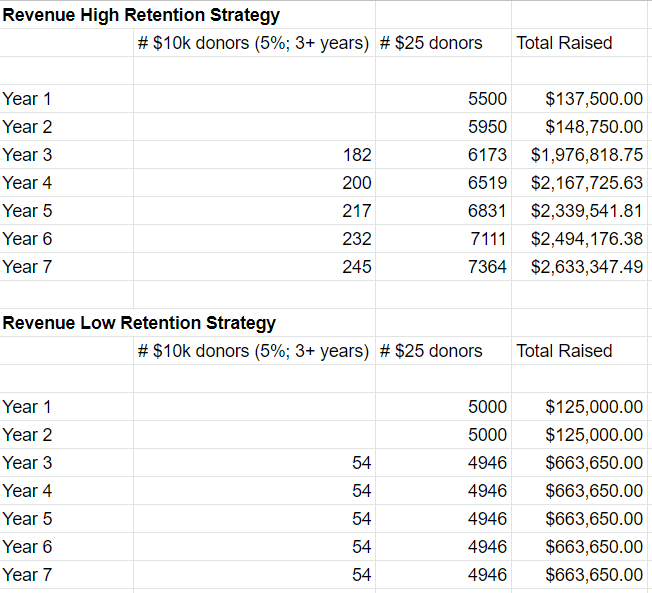
Mike:
So essentially, you’re saying that by promoting recurring gifts, you can drive donor retention, which then increases your pool of available prospects, which then exponentially drives more revenue for the entire organization. And so, it all starts with your Netflix subscription, $15 a month, right? That’s the catalyst. The more you drive that, the more you drive everything. It’s really powering the entire organization in terms of revenue in the door.
Louis:
I mean, that’s one way to think of it. Recurring gifts are self-renewing, they’re sustainable.
Mike:
This is maybe a more philosophical question, but the world has shifted to the subscription economy, right? You mentioned Netflix. Think about how many people are cutting cable and just going with Netflix, Hulu, Disney Plus, Discovery Plus, Chip and Joanna Gaines. And then you’re eating your dinner, which is delivered by HelloFresh on a weekly basis while you watch your Netflix. And then you go to bed and you get dressed in your pajamas that came via your monthly subscription box to whatever clothing subscription service…
Louis:
And then you go to work and you’re on Salesforce, or Zoom, or EverTrue. All subscription services.
Mike:
So the world has shifted there. And some of the reason is you get to see that immediate impact, right? “I’m going to pay for Netflix and then I’m going to have something to do when I can’t leave the house. I’m going to buy a box of clothes. Or, I’m going to support charity: water. And every month, they’re going to tell me how many people my giving has helped and where in the world they are.” How do we provide that same impact or the same return on investment to recurring donors?
Opt In vs. Opt Out
Louis:
There’s also a behavioral science reason behind all of that. You can drive behaviors by just being very excited about something. And this is your Giving Day or any other kind of event or campaign. They generate excitement-driven behavior, but they tend to not stick. A lot of the behaviors that do stick are because of the structure of how you ask the question. It’s not the same to opt in to do something every month and then have to opt out, than to have to opt in every year or every month to make a decision every time. That makes all the difference.
Mike:
So it’s removing the decision-making process. And instead of asking, “Do you want to support Muhlenberg every year?” you asked once, “Do you want to support Muhlenberg? Do you care about it?” And then you say, “Here, we’re going to make it easy for you to continue doing that.” Is that what you’re saying?
Louis:
Definitely. [Recurring gifts] have tremendous benefits, both to the donor and the organization. And for people that are concerned about how many letters and emails we send, that stops. And there’s a stream of support that the organization can count on. If you feel deeply about the importance of scholarships and helping students, you want the students to not know every year whether they’re going to get aid or not. You want them to be able to count on you. [A recurring gift option] also makes giving more affordable. It’s not the same to give $120 at once, then $10 every month. [The latter] is very achievable. So, the benefits really go both ways.
The Monthly-Gift-First Model
Mike:
So you’re in your second fiscal year at Muhlenberg. What have you done with the team to promote and increase donor retention, and as part of that, to promote recurring gifts?
Louis:
So I have to say, there was already so much in place here and there’s such tremendously visionary leadership that allowed me to do more, and I feel very fortunate. This fiscal year, we’re transitioning into a monthly-gift-first model. So that’s the first ask in the phone-a-thon. Our letters have the typical “ask” section, but they have a separate box for making a monthly gift. Our website is monthly-gifts-first. So, that’s the default option. For anybody that listens to this and goes running to see what we’re doing, it’s a work in progress. We have so much to learn, as does most everybody in higher-ed, but that is one of our focus areas this year.
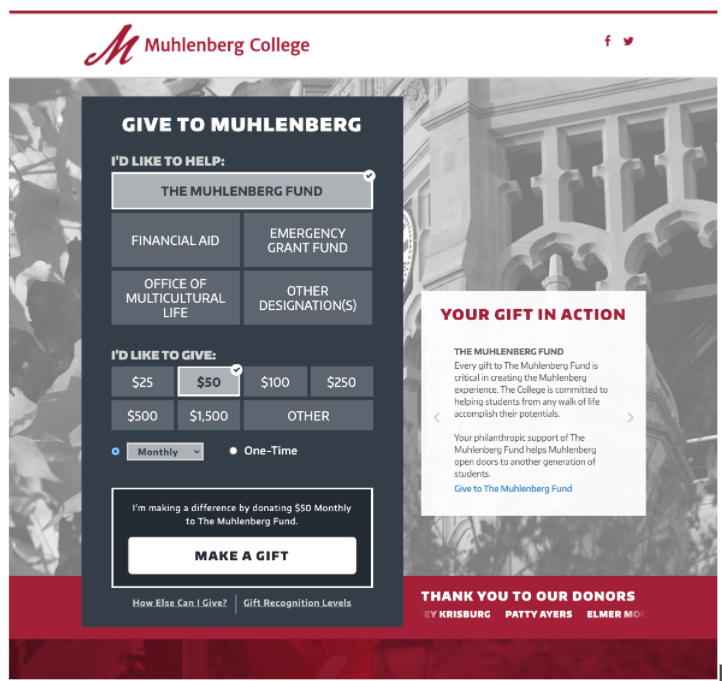
Our second focus area is community. It’s really interesting that you brought up the funnel concept, where you start with lots of people, and then you lose them as you progress through each step. There’s an alternative model that’s thinking of your constituents as a community, and it’s the opposite of this funnel. So, you start with few people and you build a community through vehicles like volunteerism, like your class agent program, by thinking holistically about your engagement and solicitation activity, and you start bringing more people into the fold.
Of course, other schools, I’ve heard them refer to this as having people drink the Kool-Aid. And so, the funnel keeps growing and growing and growing, and that’s another way to make people stick around. So one of the Donor Participation Project sessions had some really interesting research about why millennials join organizations. They may join because of a reason, like working out or having dinner together, but they stick around because of the community. And I think that applies to everybody, right? So, that’s another area where we’re trying to be very strategic.
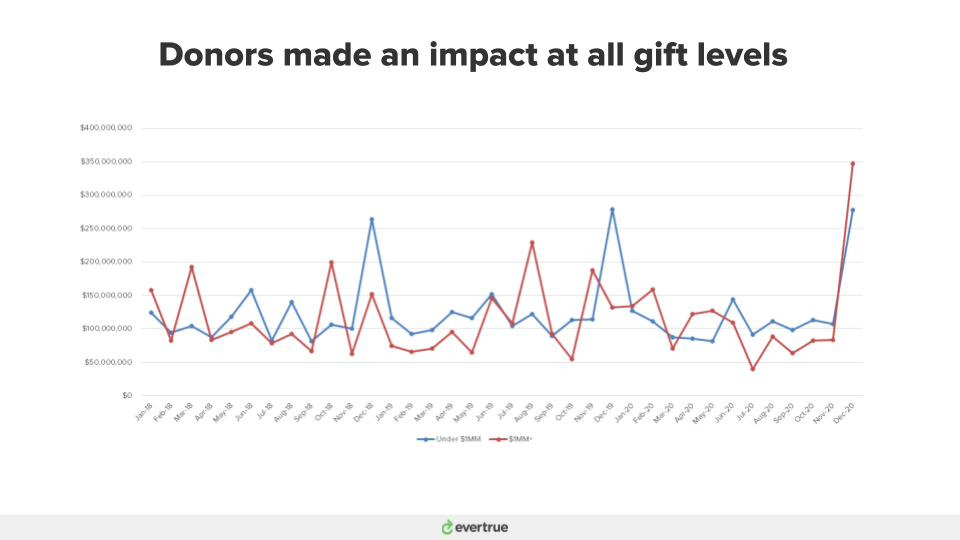
They Came for the Degree; They Stick Around for the Community
Mike:
I think one thing we forget sometimes is that we’re all emotional social creatures. We would love to tell ourselves that we make purely rational decisions. But then we do things, like in my case, I support the Buffalo Bills with an undying passion for my entire life. And I do ridiculous things, like dress up every Sunday to watch them from my couch. But, I do that because I know the rest of my family is doing the same thing all across the country where they are. And the rest of my Bills Mafia family is also doing the same thing, which perpetuates this cycle of involvement and passion and commitment.
So, I think you’re right. However you picture it, funnel or a pyramid, or you could picture a flywheel. Engagement drives more engagement. When we can do that efficiently, when we remove the obstacles for people, like connecting with each other, and social media is great at allowing people to share their stories and feel like they’re part of something bigger, that’s where I think annual giving is so transformational.
Look, I am not a major gift donor and I’m not a good major gift prospect. As I’ve progressed in my life, maybe I will be blessed and one day I will be able to [make a major gift]. But for now, my wife Sonja and I give to Heifer International because they took the time to reach out to us as past donors and say, “Hey, your gift is going to be tripled.” They had a matching gift opportunity, which is really motivational because my small investment is going to be added to exponentially, so it’s a greater instant return. But then they also said exactly what we’re going to be able to do for a family in need, and particularly a family in the Third World that has been affected by COVID that needs resources to make it through the day.
And so, with annual giving, your gift of $10 a month is added to a thousand other people doing the same thing, which equates to millions of dollars. And the amount isn’t as important as it is that we are providing an opportunity for a student to finish graduation when, for example, maybe they’ve lost their job because of a layoff. Or, we’re helping this family’s unexpected medical needs in order to complete their coursework. That’s the kind of thing that is really cool to see and is really cool to be a part of.
Louis:
Mike, you have such a big heart and I think your example shows that when you have community engagement, it’s almost like all those details that we worry about, “Is the subject line of appealing enough or is this letter long enough? Is the ask structured in the correct way?” Those kinds of things go away. It’s more like, “Hey, Mike, we need your help. There are people that are really suffering out there.” And then you’ll give. So, I did some research and I looked into really interesting people, especially in the tech sector. They’re calling it CMX, and they are really turning this community-building into a science.
The types of engagement that are most valuable, and I think this is a conversation that’s really good for higher ed, are purposeful engagements. So, we’re getting together, but it’s to do something. It’s to help somebody. It’s to organize an event. Maybe it’s to help each other and help out others. It’s recurring, so it’s not just once. It happens on an ongoing basis. And, it identifies leaders. Because, of course, we can’t do it all. We can’t put on all the events that our alumni need. We need to identify leaders and develop them and support them.
Giving Days! …and then what?
Mike:
Yes, and I think you start to see this happen with Giving Days. If it’s happening once a year versus on an ongoing basis, we’re probably not there yet, but we’re starting, right? It’s like, Giving Day is our time for our community to come together and oftentimes to solve direct individual passion problems. So maybe you have five different buckets for your Giving Day or 30 different things that can be accomplished. The best ones I’ve seen are the ones that are student and faculty-led like, “These are the things we want to do. Can you come be a part of this?” And they’re engaging alumni and parents across generations, across geographical divides to come and unite together for a purpose.
Mike:
I think it’s a missed opportunity if the Giving Day is over and we sent a thank you video, and that’s where it ends. It should be an ongoing relationship. If you participated in helping the Formula One team design and build their car and race it, you should be able to continue getting those updates to continue choosing to support that initiative if it’s important to you and make that more than just a one-time deal.
Louis:
Exactly. So, our past Giving Day, we emphasized monthly giving a good amount. I wouldn’t say we had all our ducks in a row yet. But predominantly, people wanted to make these one-off gifts. So, it highlighted a little bit of the excitement-driven versus the habit-driven behavior of giving. And we have to balance them both, of course. I mean, we want both. It’s not an either or. We’re not machines, right? But it gave us food for thought. As we plan next year, we’re definitely looking at other models. And to some extent, it’s a capacity issue, the follow-ups [after Giving Day]. So how do you keep that engagement? You gave, and what next?
There’s another book called Bowling Alone. It’s about something they call the decline of civic capital. But, basically, it used to be that there were so many engagement and civic activity opportunities everywhere. You belonged to your fraternity or sorority, your college. You had all these groups of people, and we’ve lost a lot of that. And, I think that’s a wider societal concern, but it affects us [in higher-ed].
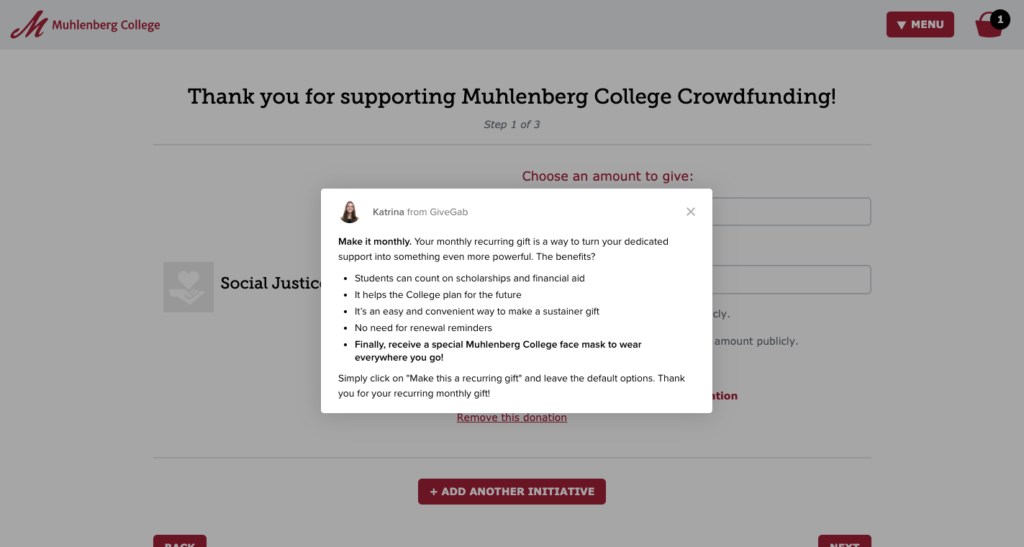
Mike:
Everybody’s looking for these connections, right? Everyone wants to be more connected, and yet we’ve also never been more isolated. Even pre-pandemic. And now, we’re super isolated. But yes, community matters more than ever. People are looking to be part of something. They’re looking to draw meaning from that. And what better place to give it to them than a place that they loved, where they spent their formative years? Higher-ed has the ability to sell something, to sell an experience that very few other institutions and organizations have, because they’ve been involved in some of the most transformational experiences of people’s lives.
Louis:
And it’s also about the mission that universities and higher education institutions have in this country, which is one of the few truly unifying, bringing-everybody-under-the-tent experiences that we still have. I still feel deeply about this, and it’s true. There’s a lack of these opportunities for community. So, people latch onto some algorithmic-driven groups on Facebook. So, there’s a void and it’s being filled in ways that I think, as a society, most of us are not very happy about.
Mike:
So, there’s an opportunity for annual giving teams to help fill that void that’s inside all of us.
Louis:
I mean, as long as it’s purposeful and obviously for a good cause. In this Bowling Alone book, he talks about two types of organizations: ones that bring people together, and I think of a choir. It brings people together of all different backgrounds. And that’s what our schools do. And then there are organizations that are about distinguishing ourselves from other people.
Mike:
Like the Mensa society.
Louis:
Exactly. And, I guess it’s good that people are engaged. But it’s not so good that some of these groups are pushing people away. I don’t know. It’s a complex matter.
Test This Out
Mike:
So we talked a little bit about recurring giving. People, I’m sure, have already been flooding your giving page. And people, look at their giving page. It’s awesome. Also, look at pricing pages on software companies like Dropbox or HelloFresh. They are changing and testing and segmenting messages with those constantly to try to make them more effective, more efficient. So you guys [at Muhlenberg] are doing the same thing. Where have you seen recurring gifts really be effective to drive donor retention?
Louis:
So, I can tell you the theory and where we are in this journey, which admittedly is only a few months old. The theory was that our loyal donors would be a particularly good group to test out this “monthly-gift-first” approach. And they have responded with generosity and loyalty as they typically do. Many of them have signed up for recurring gifts. The theory was also that this could serve as an acquisition method for our younger and even non-donors, because monthly gifts make giving very achievable.
Mike:
And [young people] are already doing it in their daily life. They’re used to that type of transaction.
Louis:
Exactly. So, we had a Donor Participation Project session, and we had somebody join from the Minnesota Public Radio and she was fantastic, she imparted so much knowledge. What we learned about this was that [recurring giving] is really a change of model. It’s not something that you can just add on as an option. You have to go all in with this. So, Mike, like you and I joked before, if Netflix let you watch a full day of movies for three bucks, you probably wouldn’t sign up for the $8 per month. So, it’s really a change of concept. And we’re getting there technically and also in our conversations with people.
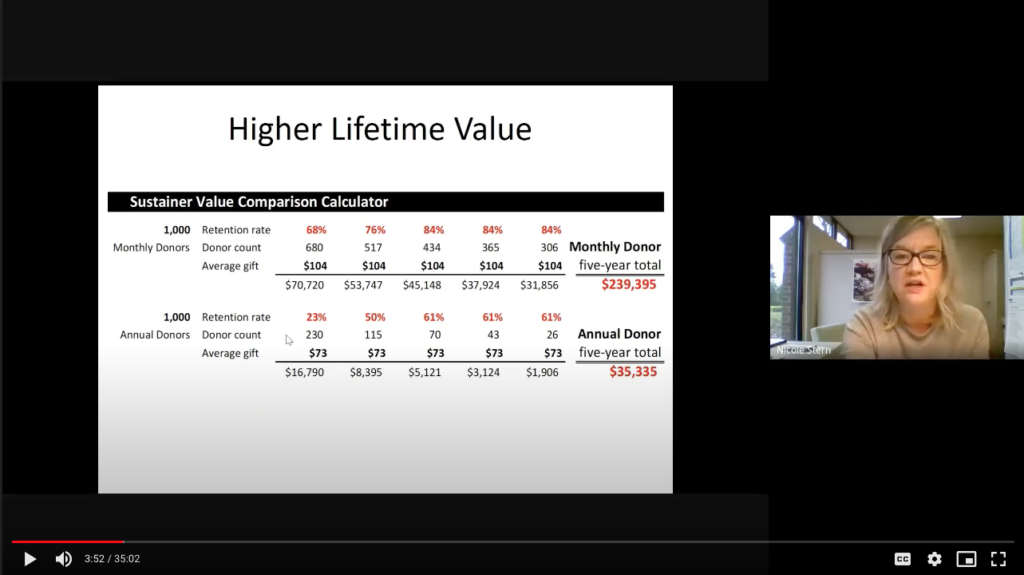
Mike:
We’ll share a link to that session. It was great. A couple of things that she highlighted that I just want to bring up. One, it costs 6 to 7 times more to bring in a new donor versus retaining your existing ones. We see that in the for-profit world. In the last five years, this is according to HubSpot, the cost to acquire customers has increased 55%. So, it’s way better to focus on who’s already giving, who’s already close to us, and continue to keep them close and invest in that relationship. And on repeat donor retention, she also cited some stats. 6 out of 10 existing donors continue to give. So, of those people who are already recurring donors, 60% continue to give. Whereas only 20% of the people who give one-off gifts, so those people who gave your last Giving Day, will give again.
Louis:
And those events are for the sector as a whole. Some of us work at institutions that reflect a higher retention rate.
Mike:
Yes, those stats are across the industry. So, what’s one thing you would change about advancement if you could?
Talent Pipeline: The Achilles Heel of Advancement
Louis:
I would say, whatever the root causes of the turnover that we have in the sector are, I’d change those. So what I most enjoy about working in Advancement is meeting and talking with brilliant people, such as yourself, such as colleagues on LinkedIn, such as my team, such as the folks at Muhlenberg. And whatever it is that we can do to just hang around for longer with these same people, I really do hope we can figure that one out because there are some really passionate, smart people. And if we’re changing and relocating every 18 months, we’re missing out on potential.
Mike:
Yes, I think we as an industry need to figure out ways to create a talent pipeline. One way to do that is to teach students that this is a career path. And then number two, is to figure out ways to allow people to progress in their careers without having to jump to another institution. And often, there are good reasons to jump. If you go from a large public to a small private, you’re going to learn different things and try different things. But at the same time, it is really hard to build future leadership at our institutions if we’re losing a lot of folks to other sectors. And so, that is definitely a big challenge. I mean, part of the reason I am EverTrue is because they gave me a way to move ahead in my career.
Louis:
Yes, the talent pipeline. It’s a thing, and I think it’s really complex. I think sales professions in general have high turnover. If you look at sales development representatives in tech, they also have huge turnover. Development is often underinvested. So, that proverbial money on the table is just left there. But nonprofits are really complex organizations. They have their fundraising arm and they have their program arm. And then it’s like a very complex balance there. Oftentimes, that causes issues too.
Mike:
What have we not talked about that you want to add?
Louis:
So, I would just say it’s a journey for everyone. Sometimes when I’m talking about this with people, they ask me, “Well, yes, but give me an example of a higher ed institution that already has a monthly giving program.” Well, number one, many of them do. You just don’t hear about it. Number two, we’re really all on this journey. I think it’s important. And that’s what the Donor Participation Project is about, let’s all just learn together, figure out what’s best for our donors and best for our organizations, and move it forward.
Mike:
Everyone should definitely check out the Donor Participation Project. There are hundreds of folks engaging with each other, sharing what they’re learning. It’s that community that’s growing, it’s building, that’s focused on retention and that is transforming the future of fundraising. We’re excited to hear from you, Louis. I cannot wait for our next conversation. This has been a blast. Thank you for coming by.
Louis:
Thank you so much, Mike. You guys are doing great work.
Want to get in touch with Louis? He’s active on LinkedIn, can be reached by email at Louisdiez@muhlenberg.edu, and runs the Donor Participation Project.
